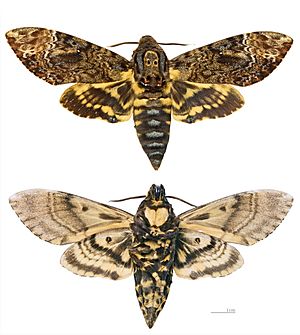Greater death's head hawkmoth facts for kids
Quick facts for kids Acherontia lachesis |
|
|---|---|
 |
|
| Acherontia lachesis | |
| Scientific classification | |
| Kingdom: | |
| Phylum: | |
| Class: | |
| Order: | |
| Family: | |
| Subfamily: | |
| Genus: | |
| Species: |
A. lachesis
|
| Binomial name | |
| Acherontia lachesis (Fabricius, 1798)
|
|
The Acherontia lachesis is a very large moth. It is one of three types of moths known as the Death's-head hawkmoth. People also call it the Bee Robber. This amazing insect can have a wingspan of up to 13 centimeters (about 5 inches).
You can find Acherontia lachesis in India and many other parts of Asia. It belongs to a group of moths called Sphingid moths or hawkmoths.
Contents
What it Looks Like
Acherontia lachesis is a striking moth. It has a unique pattern on its back that looks a bit like a human skull. This is why it's called a "Death's-head" moth.
Colors and Patterns
The moth's wings are usually dark brown and black. They have yellow or orange markings. The body is thick and furry. It often has yellow and black stripes. These bright colors can warn predators that the moth might not taste good.
Size of the Moth
These moths are quite large. Their wings can spread out to be as wide as your hand. This makes them one of the biggest moths in their family.
Life Cycle of the Moth
Like all moths, Acherontia lachesis goes through a complete metamorphosis. This means it changes a lot during its life. It starts as an egg, then becomes a larva (caterpillar), then a pupa, and finally an adult moth.
Eggs and Larvae
The female moth lays tiny eggs. These eggs hatch into caterpillars. The caterpillars are usually green or yellow. They have a rough texture and a horn-like tail.
Caterpillar's Diet
The caterpillars eat leaves from various plants. They grow very quickly. As they grow, they shed their skin several times. This process is called molting.
Pupation
When a caterpillar is fully grown, it stops eating. It then buries itself in the soil. There, it changes into a pupa. The pupa looks like a brown, oval-shaped case.
Time in the Pupa
Inside the pupa, the caterpillar transforms into an adult moth. This stage can last for several weeks or even months. It depends on the temperature and other conditions.
Adult Moth Emergence
Once the transformation is complete, the adult moth breaks out of the pupa. It then crawls out of the ground. Its wings are soft and crumpled at first. The moth pumps fluid into its wings to make them expand and harden.
Behavior and Diet
The Acherontia lachesis moth is known for some interesting behaviors. One of its nicknames, "Bee Robber," gives a clue about one of them.
Visiting Beehives
These moths are famous for entering beehives. They want to steal honey. They have a special strong proboscis (a tube-like mouthpart) that can pierce the honeycombs.
How They Avoid Bees
Scientists believe the moths have a trick to avoid being stung by bees. They can make a squeaking sound. This sound might mimic the sound of a queen bee. It could also confuse the worker bees.
Nocturnal Habits
Acherontia lachesis moths are mostly active at night. They fly around looking for food. Besides honey, they also feed on nectar from flowers and sap from trees.
Where They Live
This moth is found in many parts of Asia. Its habitat includes tropical and subtropical regions.
Geographical Range
You can find Acherontia lachesis in countries like India, Sri Lanka, China, Japan, and many parts of Southeast Asia. They prefer warm climates.
Preferred Habitats
They live in various places, including forests, gardens, and agricultural areas. Anywhere there are plants for their caterpillars to eat and flowers for the adults to feed on, they might be found.
Images for kids
See also
 In Spanish: Acherontia lachesis para niños
In Spanish: Acherontia lachesis para niños












